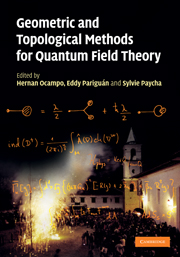Book contents
- Frontmatter
- Contents
- List of contributors
- Introduction
- 1 The impact of QFT on low-dimensional topology
- 2 Differential equations aspects of quantum cohomology
- 3 Index theory and groupoids
- 4 Renormalization Hopf algebras and combinatorial groups
- 5 BRS invariance for massive boson fields
- 6 Large-N field theories and geometry
- 7 Functional renormalization group equations, asymptotic safety, and quantum Einstein gravity
- 8 When is a differentiable manifold the boundary of an orbifold?
- 9 Canonical group quantization, rotation generators, and quantum indistinguishability
- 10 Conserved currents in Kähler manifolds
- 11 A symmetrized canonical determinant on odd-class pseudodifferential operators
- 12 Some remarks about cosymplectic metrics on maximal flag manifolds
- 13 Heisenberg modules over real multiplication noncommutative tori and related algebraic structures
4 - Renormalization Hopf algebras and combinatorial groups
Published online by Cambridge University Press: 07 September 2010
- Frontmatter
- Contents
- List of contributors
- Introduction
- 1 The impact of QFT on low-dimensional topology
- 2 Differential equations aspects of quantum cohomology
- 3 Index theory and groupoids
- 4 Renormalization Hopf algebras and combinatorial groups
- 5 BRS invariance for massive boson fields
- 6 Large-N field theories and geometry
- 7 Functional renormalization group equations, asymptotic safety, and quantum Einstein gravity
- 8 When is a differentiable manifold the boundary of an orbifold?
- 9 Canonical group quantization, rotation generators, and quantum indistinguishability
- 10 Conserved currents in Kähler manifolds
- 11 A symmetrized canonical determinant on odd-class pseudodifferential operators
- 12 Some remarks about cosymplectic metrics on maximal flag manifolds
- 13 Heisenberg modules over real multiplication noncommutative tori and related algebraic structures
Summary
Abstract
These are the contents of five lectures given at the Summer School “Geometric and Topological Methods for Quantum Field Theory,” held in Villa de Leyva (Colombia), July 2–20, 2007. The lectures are meant for graduate or advanced undergraduate students in physics or mathematics. They include references, many examples and some exercises.
Part I is a short introduction to algebraic and proalgebraic groups, based on some examples of groups of matrices and groups of formal series, and their Hopf algebras of coordinate functions.
Part II presents a greatly condensed review of classical and quantum field theory, from the Lagrangian formalism to the Euler–Lagrange equation and the Dyson–Schwinger equation for Green functions. It poses the main problem of solving some nonlinear differential equations for interacting fields.
In Part III we study the perturbative solution of the previous equations, expanded in Feynman graphs, in the simplest case of the scalar ø3 theory.
Part IV introduces the problem of divergent integrals appearing in quantum field theory, the renormalization procedure for the graphs, and how the renormalization affects the Lagrangian and the Green functions given as perturbative series.
Part V presents the Connes–Kreimer Hopf algebra of renormalization for the scalar theory and its associated proalgebraic group of formal series.
Groups and Hopf algebras
In this part we review the classical duality between groups and Hopf algebras of certain types. Details can be found, for instance, in [16].
Algebras of representative functions
Let G be a group, for instance, a group of real or complex matrices, a topological group or a Lie group. Let
denote the set of functions on G, possibly continuous or differentiable.
- Type
- Chapter
- Information
- Geometric and Topological Methods for Quantum Field Theory , pp. 159 - 219Publisher: Cambridge University PressPrint publication year: 2010



